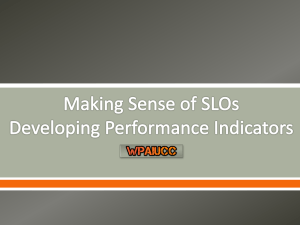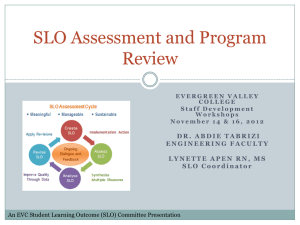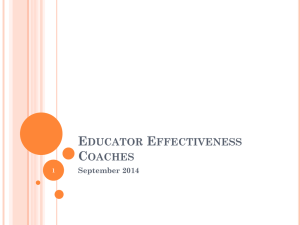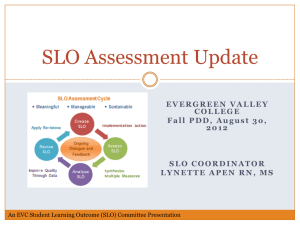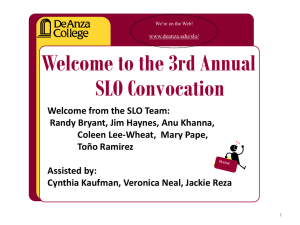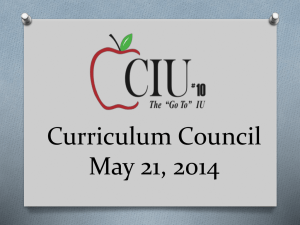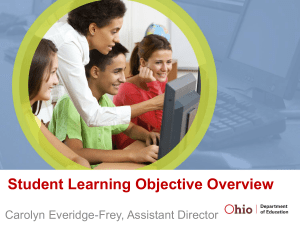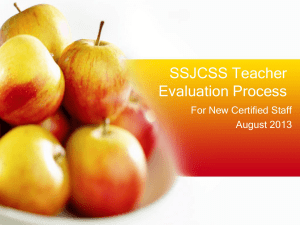SLO Powerpoint - Northeastern School District
advertisement
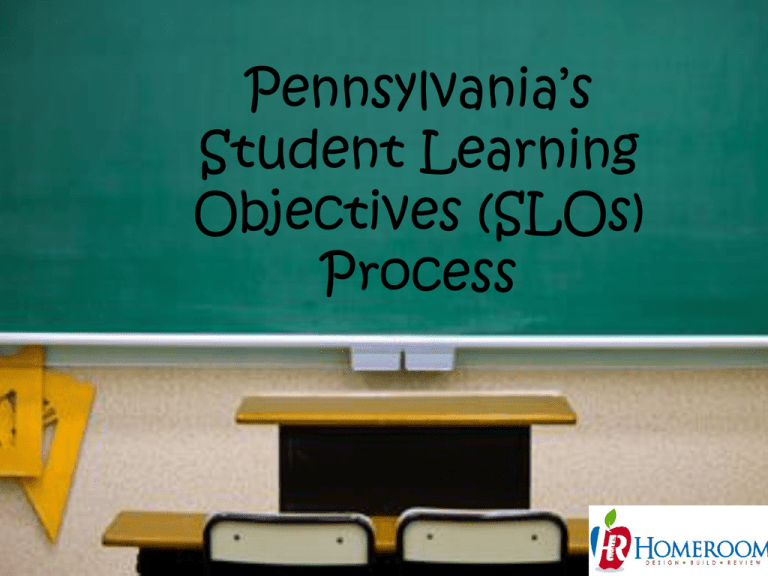
Pennsylvania’s Student Learning Objectives (SLOs) Process 1 To know what Student Learning Objectives (SLOs) are To know how SLOs fit into the larger picture of Educator Effectiveness To explore the SLO Template To know the three components in developing SLOs (Design, Build, and Review) To know where you can find the tools to develop your SLOs To give you time to begin brainstorming/drafting your SLO 2 Missy Bream Charley Dittrich Laura Davenport Rusty McCollum Justin Tate Danny Leiphart Greg Zirkle 3 SLO Overview/Training Remain in Auditorium Move to work groups with pilot team members Collaborate with group/work independently 4 What is the role of Student Learning Objectives in Pennsylvania’s Teacher Evaluation System? 7 35% 8 What is a Student Learning Objective? Student Learning Objective PDE’s Definition: A process to document a measure of educator effectiveness based on student achievement of content standards. 10 SLO Concepts Student achievement can be measured in ways that reflect authentic learning of content standards. Educator effectiveness can be measured through the use of student achievement. Many factors can influence the size of an SLO, Time Frame Course Content Important Learning Needs but the process remains the same. WHAT IT IS SUPPOSED TO BE: WHAT IT IS NOT SUPPOSED TO BE: More paperwork for • More paperwork teachers thatforhas no teachers that has no meaning or purpose meaning or purpose More testing for students • A format to inform strong instructional practice and strong student achievement • A way to measure teacher effectiveness based on student achievement • An opportunity for teachers to define, describe and present data on student achievement in the content area that they teach • More testing for students A weak substitute for PVAAS or other • Astandardized weak substitute for testing PVAAS data or other standardized testing data I will not be afraid. I will not be frustrated. I will not be angry. I will not be crabby. We’ve got this!! SLO Process Components DESIGN • Thinking about what content standards to measure • Organizing standards and measures • Discussing with colleagues collective goals • Researching what is needed for a high quality SLO 16 SLO Process Components BUILD • • • • Selecting the performance measure(s) Developing targets and expectations Completing the template Sharing the draft materials with other colleagues 17 SLO Process Components REVIEW • Checking the drafted SLO (including the performance measures for quality) • Refining measures and targets • Editing text and preparing discussion points/highlights for principal • Finalizing materials • Updating completed SLOs with performance data 18 Student Learning Objective (SLO) Template SLO Template Criteria 1. Goals are based upon the “big ideas” within the content standards. 2. Performance indicators are specific, measureable, attainable, and realistic. 3. Performance measures should be valid, reliable, and rigorous assessments. 4. Data should be collected, organized, and reported in a consistent manner. 5. Teacher expectations of student achievement should be demanding. The SLO process facilitates a conversation about expectations between educators (principals and teachers, teachers and teachers) SLO Template Steps: Teacher 1. Classroom Context 1a. Name 1b. School 1c. District 1d. Class/ Course Title 1e. Grade Level 1f. Total # of Students 1g. Typical Class Size 1h. Class Frequency 1i. Typical Class Duration 2. SLO Goal 2a. Goal Statement 2b. PA Standards 2c. Rationale Spanish 1 Students will be able demonstrate effective communication in the target language by speaking and listening, writing, and reading. 8th Grade Art Students will demonstrate the ability to manipulate visual art materials and tools to create works based on the ideas of other artists and to evaluate the processes and products of themselves and other artists. Grade 5 Library Students will demonstrate the ability to use online D.P.S. databases and search engines, Britannica Elementary, Culture Grams, and Nettrekker toward support real world experiences and determining which is the best source for specific information. SLO Template Steps: Teacher 1. Classroom Context 1a. Name 1b. School 1c. District 1d. Class/ Course Title 1e. Grade Level 1f. Total # of Students 1g. Typical Class Size 1h. Class Frequency 1i. Typical Class Duration 2. SLO Goal 2a. Goal Statement 2b. PA Standards 2c. Rationale Targeted content standards used in developing the SLO. Arts and Humanities: 9.1, 9.2, 9.3, 9.4 http://pdesas.org/ SLO Template Steps: Teacher 1. Classroom Context 1a. Name 1b. School 1c. District 1d. Class/ Course Title 1e. Grade Level 1f. Total # of Students 1g. Typical Class Size 1h. Class Frequency 1i. Typical Class Duration 2. SLO Goal 2a. Goal Statement 2b. PA Standards 2c. Rationale Explains why the SLO is important and how students will demonstrate learning of the standards through this objective.. Grade 8 Art: Developing the ability to manipulate visual art materials and tools are important to the artistic creation process, as is the ability to evaluate the process and product created by oneself and others. Child Development (FCS) Understanding how children grow and develop will prepare individuals and families to meet challenges associated with raising children. SLO Template Steps: Teacher 3. Performance Indicators (PI) PI Target #1 PI Target #2 PI Target #1 PI Target #2 3a. PI Targets: All Student Group 3b. PI Targets: Subset Student Group (optional) 3c. PI Linked (optional) 3d. PI Weighting (optional) Describes individual student performance expectation 3a. What performance measure(s) – tests, assessments– will be used to measure student achievement of the standards, and what’s the expected student achievement level based on the scoring system for those measures? 3b. What’s the expected achievement level for unique populations? (IEP, students who did not do well on a pre-test, etc.) Performance Indicator Statement HS Choral Individual Vocal Assessment Task Students will achieve proficient or advanced levels in 6 out of 8 criteria of the second scoring rubric. 5th Grade ELA DRA text gradient chart Students will demonstrate one year of reading growth SLO Template Steps: Teacher 4. Performance Measures (PM) PM #1 4a. Name 4c. Purpose 4b. Type PM #2 PM #1 4d. Metric 4e. Administration Frequency 4g. Resources/ Equipment PM #2 PM #1 PM #2 PM #1 4f. Adaptations/ Accommodations ____District-designed Measures and ____ Examinations ____Nationally Recognized Standardized Tests ____Industry Certification Examinations ____Student Projects ____Student Portfolios ____ Other:______________________________ Growth (change in student performance across two or more points in time) Mastery (attainment of a defined level of achievement) Growth and Mastery IEP Gifted IEP ELL Other PM #1 PM #2 PM #1 PM #2 4h. Scoring Tools PM #2 4i. Administration & Scoring Personnel PM #1 PM #2 4j. Performance Reporting SLO Template Steps: Teacher 5. Teacher Expectations 5a. Level Failing 0% to ___ % of students will meet the PI targets. Needs Improvement ___% to ___% of students will meet the PI targets. Proficient ___% to ___% of students will meet the PI targets. Distinguished ___% to 100% of students will meet the PI targets. . Teacher Signature _________________________Date______ Evaluator Signature _____________________Date______ Distinguished (3) 5b. Elective Rating Notes/Explanation Proficient (2) Needs Improvement (1) Failing (0) . Teacher Signature _________________________Date______ Evaluator Signature _____________________Date______ Describes the number of students expected to meet the performance indicator criteria. 5a: Proficient 85% to 94% of students meet the performance indicator. Educator Effectiveness: SLO Growth or Mastery Does this assessment/ performance task align with the student achievement goals for the SLO? Check one: Growth (change in student achievement across two or more points in time) Mastery (attainment of a defined level of achievement) Growth and Mastery www.education.state.pa.us > 39 Student Learning Objective (SLO) Resources Training Resources SAS is the PDE website containing… • the Pennsylvania content standards and other helpful PDE developed material • a downloadable SLO training “packet”, including SLO Models • links to Research in Action’s training platform, Homeroom Homeroom is RIA’s web-based learning platform that contains… • on-line training materials, including the SLO Process Template 10 • downloadable SLO training files, except the videos • links to SAS portal 41 www.pdesas.org Click on Homeroom link. (right hand side below Teachscape link) Click on RIA Homeroom Site link. Login OR Click on Register to create a login account. I suggest using a familiar login and password (i.e. your email login and password) Once finished, you will be directed to a screen like the image to the right: 42 SLO stands for _________________________. The three steps in developing a SLO are _________, _________, and ___________. SLO data fits into what category of the Educator Effectiveness pie? What will the percentage be for 20142015? An example of a performance measure is ____________. The two places I can find additional SLO resources are ___________________ and ___________________. 44 45 Remain in the auditorium with Missy and Stacey Move to work groups with pilot team members Library – Laura and Charley Rm. 200 – Danny and Greg Rm. 206 – Rusty and Justin Collaborate with group/work independently 46
